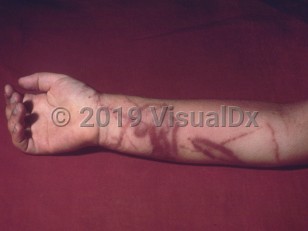The Hawaiian box jellyfish, Carybdea alata, is a small jellyfish that inhabits the tropical waters of the Pacific and Atlantic Oceans. It has a transparent, square-shaped bell up to 7.6 cm (3 inches) tall and from each corner hangs a thin, pinkish tentacle that is up to 0.6 meters (2 feet) long. The tentacles are covered with millions of stinging cells (nematocysts) that can inject toxin when touched. Unlike most jellyfish, the Hawaiian box jellyfish are fast swimmers and actively pursue prey.
Since 1988, the Hawaiian box jellyfish has been regularly invading the shallow waters off Oahu's leeward beaches (such as Waikiki) 8-10 days after the full moon. It is still unclear why the jellyfish invasion is so cyclic, but shortly after the full moon, swarms of jellyfish are spotted and hundreds of jellyfish stings may occur in one day.
The Hawaiian box jellyfish venom is not well characterized. One component appears to be hemotoxic.
The sting of a Hawaiian box jellyfish is described as extremely painful. Localized reactions include erythema, edema, and wheals. The victim may experience pruritus, muscular weakness, paresthesias, and lymphadenopathy in the affected extremity.
Systemic symptoms may include transient shortness of breath and shock. Anaphylaxis may occur. There have been no reported fatalities. There has been one case report of a persistent cutaneous hypersensitivity reaction.
Hawaiian box jellyfish sting
Alerts and Notices
Important News & Links
Synopsis

Codes
ICD10CM:
T63.621A – Toxic effect of contact with other jellyfish, accidental (unintentional), initial encounter
SNOMEDCT:
241833002 – Poisoning by box jellyfish sting
T63.621A – Toxic effect of contact with other jellyfish, accidental (unintentional), initial encounter
SNOMEDCT:
241833002 – Poisoning by box jellyfish sting
Look For
Subscription Required
Diagnostic Pearls
Subscription Required
Differential Diagnosis & Pitfalls

To perform a comparison, select diagnoses from the classic differential
Subscription Required
Best Tests
Subscription Required
Management Pearls
Subscription Required
Therapy
Subscription Required
References
Subscription Required
Last Updated:05/26/2020
 Patient Information for Hawaiian box jellyfish sting
Patient Information for Hawaiian box jellyfish sting
Premium Feature
VisualDx Patient Handouts
Available in the Elite package
- Improve treatment compliance
- Reduce after-hours questions
- Increase patient engagement and satisfaction
- Written in clear, easy-to-understand language. No confusing jargon.
- Available in English and Spanish
- Print out or email directly to your patient
Upgrade Today


